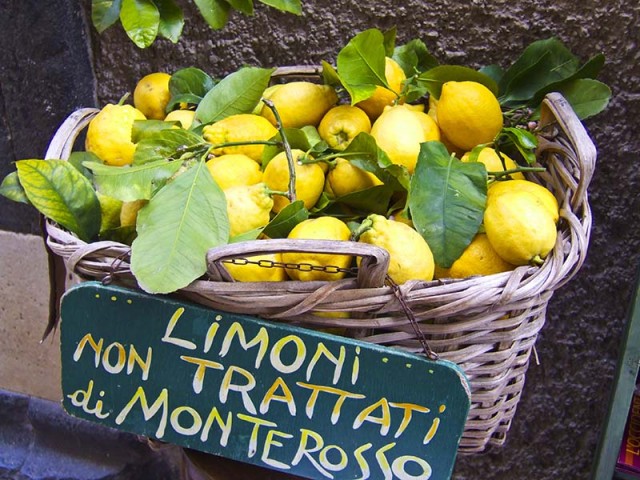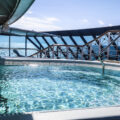
It was 9 a.m. and I was doing something I never do at that hour: knocking back an after dinner drink.
Six of us on a private van tour were visiting a citrus grove on Italy’s romantically picturesque Amalfi Coast. The trees were heavily laden with Sorrento lemons that can grow to the size of footballs and are harvested to brew up the local specialty liqueur known as Limoncello.
A little of this sweet concoction that’s designed to be a digestif goes a long way so early in the morning, because it is 35 percent alcohol. Fortunately, this is Italy, so I could follow it up with a double shot of espresso that helped get me back into focus in a hurry.
I’d need my full attention on a very ambitious personalized tour agenda organized for me and five friends by Royal Caribbean during the port call of Voyager of the Seas at Naples. We’d decided to try to combine two of the most famous local attractions: the alluring Amalfi Coast south of Naples and the haunting remnants of the ancient city of Pompeii into a day-long excursion. Along the way, we would make multiple stops to take in the unique scenery and visit farms to taste the local produce.

Our next stop is a visit to a charming local dairy on a hillside that has a panoramic view of the coast for a look at how they make the local specialty, buffalo mozzarella. No, it wasn’t invented in a city in upstate New York. In the Amalfi Coast region they raise water buffalo for milking and the rich whole milk is curdled and ground up in a mill.
When the mix is placed in hot water it gets a rubbery texture, then the cheese maker kneads it like bread dough until it forms strands that are cut in pieces (the Italian word for them is mozzare, which means lopped off). The resulting cheese is placed in cold water and then rinsed with a brine to give it a bit of a salty tang. It’s all in the wrist and patience the cheese maker insists, as she creates a fist-size lump of the delicate white cheese in a matter of minutes.
This mozzarella is unlike any you can find anywhere outside southern Italy. It’s so delicate, it’s meant to be eaten fresh and not even refrigerated. And it’s made in such small batches that if you don’t go to a dairy and buy it in the morning, you could easily find it sold out by afternoon.
So it’s a rare treat to be able to sit in the shade of a tree and sample the still warm and slightly sweet cheese in an arbor of trees that frame the coast of the Gulf of Salerno in the background.

Then, it’s on to Sorrento itself, after a drive by the village of Positano and a stop for the million dollar view from the top of a cliff looking out over the turquoise water of the bay of the Sorrento peninsula.
I’d somehow pictured Sorrento as a fishing village with a quaint harbor, but the city itself is perched on a cliff and there’s no sea view from the main squares. The crowded narrow pedestrian streets that are the major draws for tourists ae geared to the needs of souvenir shoppers and seekers of pizza and gelato.
My alternative was to check out the splendid churches and palaces of the old city, which date back to the Renaissance and tour the collection of Neapolitan art at The Museum Correale.
But we are on a whirlwind itinerary and after 90 minutes, it’s back on the van for the drive to the last stop of the day, the archaeological site of the sprawling city of Pompeii, that was tragically buried along with its inhabitants by a massive eruption of Mount Vesuvius nearly 2,000 years ago.

Visitors could easily spend most of a day walking Pompeii’s along the ancient stone streets and peering into the first floors and foundations of its once grand buildings. The frescoes on remaining walls and elaborately decorative mosaics on floors hint at the beauty and wealth of the city that was.
It’s sobering to realize that the crater of Vesuvius is still smoking and towers over Naples, which has a much bigger population than Pompeii did and to realize that the volcano had a significant eruption as recently as 1944. Meanwhile its cousin Mount Etna on the island of Sicily has already erupted twice in 2011, spewing out spectacular plumes of ash and lava.
Finally it’s back to the van for the drive back to the ship, which by the time we’re back on board is preparing to start serving dinner. Whew. It was a fascinating day, but next time I think I’d opt for doing one destination or the other.
And I will be back. All roads may lead to Rome, but nearly all the itineraries of cruises around Italy stop in Naples. And there are plenty of choices for excursions.
Other popular options for a day in Naples include tours of the city of Naples, taking a hydrofoil or ferry to the Isle of Capri, climbing Mount Vesuvius and visiting Pompeii’s smaller but better preserved sister city Herculaneum.






